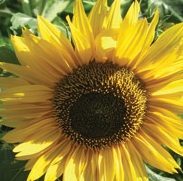Today I planted my Peredovik Black Oil Sunflower Seed from Russia. They are the black oil sunflower seeds that the birds love to eat and this is the variety that is in your bird seed mix that you buy in the store. They are particularly good because they are high in natural fat giving the birds energy. This makes them the best choice of sunflower for feeding birds although the birds love all varieties of sunflower seeds.
I got mine for 2016 from Southern Seed Exchange and can’t wait for them to come up. Just plant like any other sunflower seed mixed in your garden with other flowers. They have multiple heads on each stalk. They won’t be as tall as some of the giant sunflowers usually reaching 4-5 feet tall but it’s nice to know I’m helping the birds. After they flower, I leave the heads on and it’s fun to watch the birds eat them right off the plant in the fall. I leave them well into winter where the wild birds will continue to get the seeds out of the heads.







